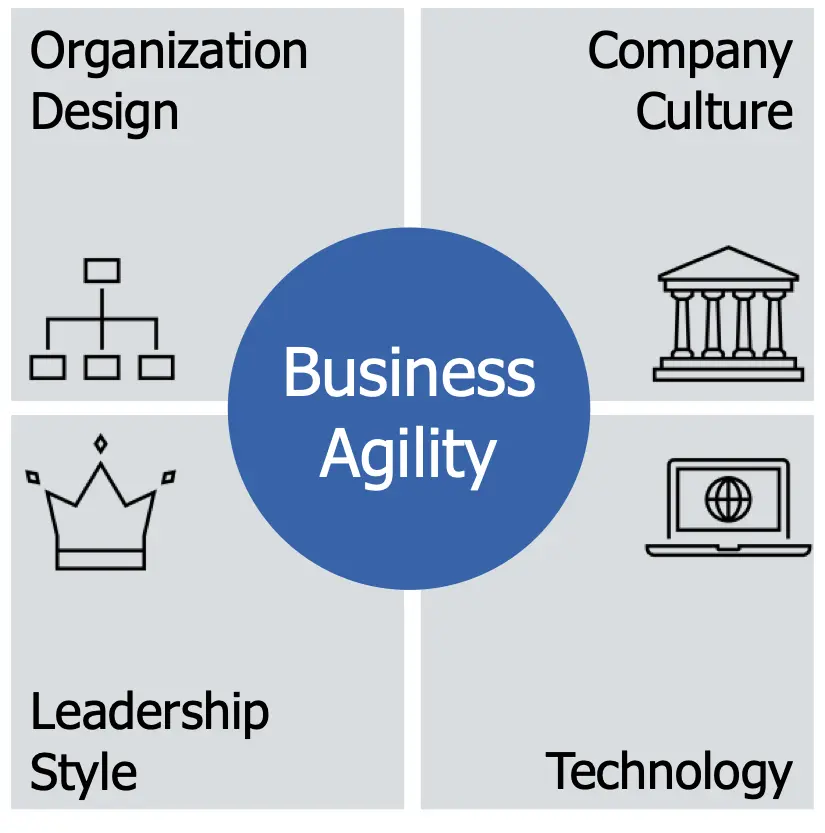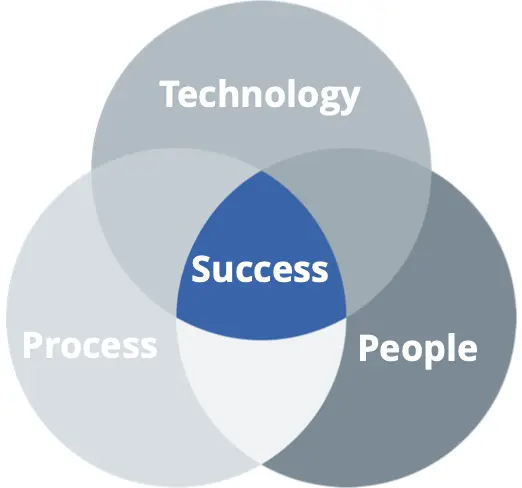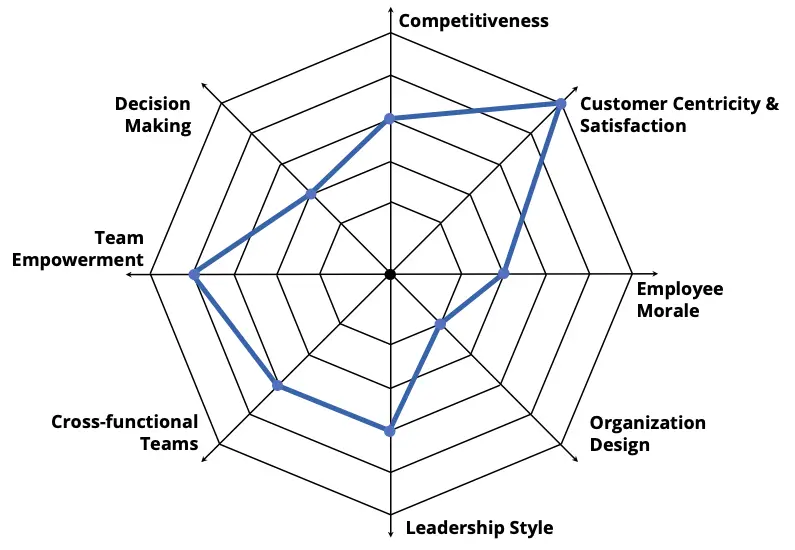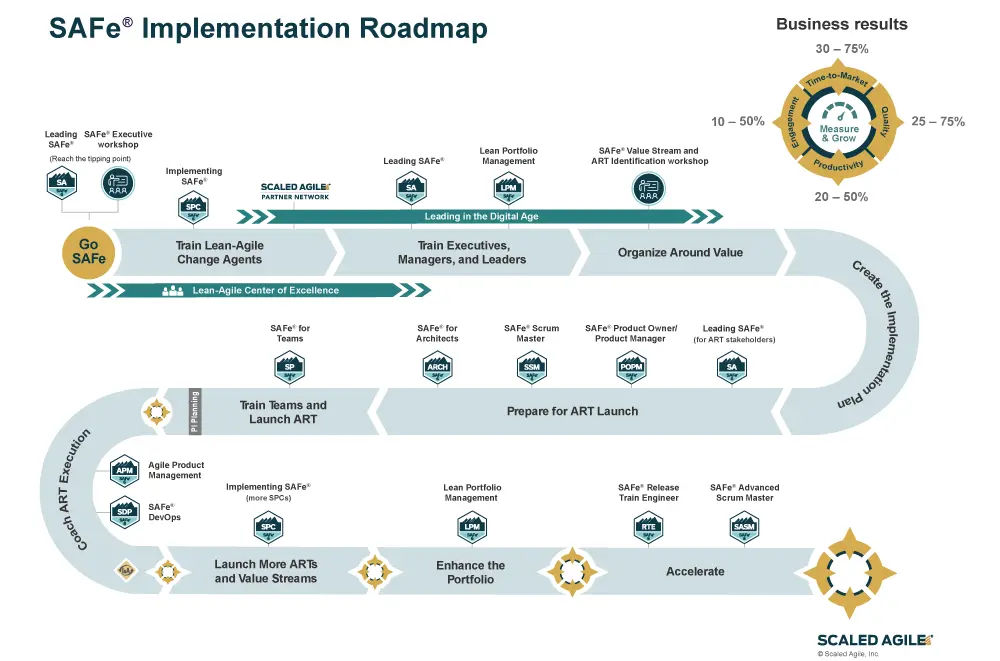
Survival in digital competition - Business Agility
Essential Guide to Business Agility and Staying Competitive in the Digital Age
What is Business Agility? How is it defined?
Business agility refers to an organization’s ability to respond quickly to market changes, continuously drive innovation, and rapidly meet customer demands. It describes the flexibility with which companies react to new opportunities or threats, deliver value, and demonstrate resilience. Business agility is the capability of a company to remain competitive and effective in a rapidly changing environment. It encompasses the speed, balance, and adaptability with which a business can respond to new challenges, opportunities, and market changes. Business agility ensures that a company not only reacts to change but also leverages it to consistently and sustainably deliver value to customers.

Pillars of Truly Agile Businesses
Truly agile businesses are built on several foundational pillars that intertwine organizational structure, leadership, culture, and technology.
Organizational Structure
Agile organizations are characterized by their flexible structures which are designed to enable quick decision-making and effective cross-functional collaboration. This often means flattening hierarchies, dismantling silos, and forming multidisciplinary teams that can operate autonomously. These teams are empowered with the resources and authority to execute tasks without the traditional encumbrances of bureaucracy, enabling a faster response to change.
Leadership Style
Leadership in agile organizations transcends traditional command-and-control models. Agile leadership is servant leadership—it facilitates, mentors, and empowers rather than directs. Leaders in such environments serve as enablers, fostering a sense of ownership among employees, encouraging initiative, and nurturing the agile mindset throughout the organization. They are also adept at change management, guiding their teams through transitions with a clear vision and a supportive stance.
Company Culture
The culture of a business agile company is one of its most defining aspects. It is a culture that values and promotes flexibility, innovation, and a willingness to experiment and learn from outcomes, whether they are successes or failures. A truly agile culture is built on trust and open communication, where feedback is welcomed and acted upon. This culture encourages continuous improvement and values the process of learning as much as the end result.
Technology as a Driver for Business Agility
In the context of business agility, technology acts as both an enabler and an accelerator. Agile companies leverage cutting-edge technologies such as cloud computing, artificial intelligence, and machine learning to gain insights, streamline operations, and deliver products and services efficiently. These technologies facilitate real-time data analysis, support rapid prototyping, and allow for more personalized customer experiences. However, technology is not just a set of tools but a strategic asset that, when aligned with business goals, can significantly enhance the organization’s agility.
In essence, business agility intertwines these pillars to create a dynamic capability that allows companies to adapt, innovate, and thrive. Organizations that excel in each of these areas can respond to changes with speed and confidence, turning potential disruptions into opportunities for growth.
Why Business Agility is Important for Your Business?
In the digital age, where technology evolves at breakneck speed and consumer preferences can shift overnight, business agility becomes not just beneficial but essential for survival and success. The importance of business agility can be understood in terms of its positive impacts on a company’s competitive edge, as well as the negative consequences of its absence.
Positive Impacts of Achieving Business Agility
- Enhanced Responsiveness to Market Changes: Agile companies can quickly respond to market changes, whether it’s a shift in consumer demand, a new regulatory requirement, or the emergence of a disruptive technology. This responsiveness allows them to stay relevant and often ahead of the competition.
- Increased Innovation: Agility encourages a culture of continuous improvement and experimentation. This can lead to more innovative products and services, as teams feel empowered to try new ideas and learn from the outcomes, keeping the company at the forefront of innovation.
- Faster Time-to-Market: With streamlined processes and a focus on value delivery, agile businesses can reduce the time it takes to move from concept to commercialization, allowing them to capitalize on opportunities more quickly than their less agile competitors.
- Improved Customer Satisfaction: Business agility enables companies to be more attuned to customer feedback and rapidly adapt their offerings to meet customer needs. This not only increases customer satisfaction but also builds loyalty and can lead to more positive word-of-mouth referrals.
- Better Risk Management: Agility allows for a more proactive approach to risk management. Companies can anticipate potential issues and pivot before the risks materialize into significant problems, thus avoiding costly setbacks.
- Attraction and Retention of Talent: A dynamic and responsive work environment is attractive to the modern workforce. Agile businesses are likely to attract innovative, proactive employees and will typically have higher retention rates due to increased employee engagement and satisfaction.
Negative Impacts of Lack of Business Agility
- Loss of Market Share: Companies that cannot adapt quickly to market changes are at risk of losing market share to more agile competitors who can meet market demands in real-time.
- Decreased Relevance: Without the ability to pivot and adapt, companies risk becoming obsolete as their products, services, or business models become outdated in the face of new, more relevant offerings from agile competitors.
- Slower Decision-Making: Non-agile companies often suffer from slow and cumbersome decision-making processes, which can delay important initiatives and hamper the company’s ability to react to external pressures.
- Lower Employee Morale: A lack of agility can lead to frustration and low morale among employees who may feel stifled by bureaucracy and the slow pace of change, leading to reduced productivity and higher turnover.
- Inability to Leverage New Technologies: As digital technologies evolve, non-agile companies may struggle to adopt and integrate these technologies effectively, missing out on the operational efficiencies and new business models they enable.
- Financial Inefficiencies: The inflexibility of non-agile businesses often leads to higher operational costs due to inefficiencies and the inability to scale or contract in response to market fluctuations.
In summary, business agility in the digital competition landscape is a key determinant of a company’s ability to maintain a competitive edge, innovate, and meet customer needs efficiently. Conversely, a lack of agility can render a company slow, unresponsive, and ultimately irrelevant in an increasingly dynamic market. Companies that cultivate agility can turn the rapid pace of change to their advantage, using it as a catalyst for growth and success.
How to Assess Your Level of Business Agility?
Assessing an organization’s maturity in terms of business agility requires a comprehensive evaluation across various facets of its operations, culture, and structure. Here’s how you can assess the agility of your organization, including positive indicators that signify a high degree of business agility and negative indicators that suggest areas that may need improvement.

Positive and Negative Indicators of Business Agility
Competitiveness:
- Positive: The company frequently releases products or features that set industry trends and responds effectively to competitive threats.
- Negative: The company is often playing catch-up with competitors and struggles to maintain its market share.
Customer Satisfaction and Centricity:
- Positive: There is consistent positive feedback from customers, and products/services are regularly updated based on customer input. The company has high Net Promoter Scores (NPS).
- Negative: Customer complaints are frequent, and there’s little evidence of customer feedback leading to changes in products or services.
Employee Morale:
- Positive: Employees are engaged, exhibit a high level of job satisfaction, and speak positively about the company culture and management.
- Negative: There are high rates of employee turnover, frequent expressions of job dissatisfaction, and a visible lack of engagement.
Organization Design:
- Positive: The company structure supports autonomy and is adaptable, with a focus on removing unnecessary bureaucracy.
- Negative: The organizational structure is rigid, hierarchical, and departmentalized, creating silos.
Leadership Style:
- Positive: Leaders exhibit a facilitative and empowering style, promoting autonomy and a shared vision.
- Negative: Leadership relies on command-and-control practices, with little delegation or trust in team decisions.
Cross-Functional Teams:
- Positive: Teams include members from various functions working together towards common goals, fostering innovation and reducing time-to-market.
- Negative: Cross-departmental collaboration is rare, and teams often work in silos, leading to duplicated efforts and a slow response to market needs.
Team Empowerment:
- Positive: Teams are given the autonomy to make decisions and are provided with the resources they need to execute their tasks effectively.
- Negative: Teams depend on management for decisions, and there is a lack of trust in their expertise and decision-making abilities.
Way of Decision-Making:
- Positive: Decision-making is decentralized, and employees at all levels are involved in the process, leading to faster and more customer-centric decisions.
Negative: Decision-making is slow and centralized, with a top-down approach that doesn’t leverage frontline employee insights.

Visualization of Progress concerning Business Agility as Spider Web Diagram
The result of the multi-dimensional factors can be shown as Spiderweb Diagram.
In conclusion, assessing your organization’s business agility maturity involves looking at a range of factors, from how your company innovates and competes, to how it engages with customers and empowers its employees. Organizations high in agility will show strong positive indicators across these areas, while those low in agility will need to address the negative indicators to improve their competitive stance in the digital marketplace.
Why it is Crucial to Work on Your Organization, Company Culture, Leadership Style in Combination with Cutting Edge Technology to achieve business agility?
The pursuit of business agility is not merely about adopting the latest technologies; it’s about a holistic transformation of the entire organization. This transformation encompasses the organizational structure, company culture, leadership style, and the strategic use of technology. Each of these elements plays a crucial role in achieving true agility, and they are deeply interdependent.
Organizational Structure: Agile organizations are marked by structures that promote fast decision-making and adaptability. Hierarchical, rigid structures inhibit the flow of information and slow down the response to change. By working on creating more flat and flexible organizational structures, companies can empower their teams, reduce bottlenecks, and enable a quicker response to the market.
Company Culture: Culture is the collective behavior of an organization; it’s the shared values, practices, and norms that define the way work gets done. An agile culture is one that supports and drives change rather than resists it. This means valuing transparency, fostering continuous improvement, encouraging innovation, and tolerating well-intentioned failures as a source of learning. Without a culture that supports agility, even the best strategies and tools will fail to make an organization nimble.
Leadership Style: Leaders in an agile environment need to embody and promote the principles of agility. This means moving away from command-and-control leadership to a more servant leadership approach that empowers employees, values their contributions, and supports their growth and autonomy. Leaders set the tone for the organization, and their behavior and mindset must support the agile transformation for it to be successful.
Cutting-Edge Technology: Technology is a crucial enabler of agility. Cloud computing, for example, provides scalability and flexibility, AI and machine learning offer predictive insights and automation, and agile software development practices enable rapid iteration and deployment. However, technology alone is not sufficient. It must be thoughtfully integrated into business processes, with the support of a culture and leadership style that can leverage it effectively.
By focusing on these areas in concert, organizations can create an environment where agility thrives. A flexible organizational structure allows for rapid pivots; a supportive culture encourages innovation and accepts the risks that come with it; an empowering leadership style attracts and retains the talent necessary to drive change, and cutting-edge technology provides the tools required to compete in a digital world.
Business agility is, therefore, not the domain of any single aspect of an organization. It emerges from the confluence of all these factors, each reinforcing the other to create a company that can not only survive but thrive amidst the uncertainties of the digital age. The integration of these elements leads to a holistic agility that permeates every level of the organization, enabling it to respond to external pressures and opportunities with speed and confidence.
How to implement Step by Step Business Agility?
Improving business agility is a strategic process that requires careful planning, execution, and the cooperation of the entire organization. The Scaled Agile Framework (SAFe) provides a roadmap for large organizations to adopt agile practices at scale. Here’s a step-by-step guide on how to use SAFe to improve business agility, including the roles involved in the process:
Step 1: Reach a Consensus on the Need for Change
Initiation:
- Conduct an assessment to determine the current state of agility within the organization.
- Engage key stakeholders and leadership to build awareness of the benefits of SAFe and the need for change.
- Decide on the scope and objectives of the SAFe transformation.
Roles Involved:
- Executive sponsors
- Change agents
- Management
Step 2: Get Trained and Educated
Training:
- Provide comprehensive training on SAFe principles and practices to everyone involved in the transformation.
- Focus on training for specific roles such as Scrum Masters, Product Managers, and Agile Coaches.
Roles Involved:
- SAFe Program Consultants (SPCs)
- Agile Coaches
- Scrum Masters
- Product Managers
- System and Solution Architects
Step 3: Plan the Implementation
Implementation Planning:
- Create an implementation plan using the SAFe Implementation Roadmap.
- Form a Lean-Agile Center of Excellence (LACE) to guide and oversee the transformation.
Roles Involved:
- LACE members
- SPCs
- Agile Coaches
Step 4: Train Teams and Launch Agile Release Trains (ARTs)
Team Formation:
- Organize teams into Agile Release Trains, the primary value delivery construct in SAFe.
- Conduct training for all team members and execute a Program Increment (PI) Planning session to align teams to a common mission and vision.
Roles Involved:
- Release Train Engineers (RTEs)
- Scrum Masters
- Product Managers/Owners
- Team members
Step 5: Coach ART Execution
Agile Execution:
- Guide and support the ARTs through their development cycles, ensuring continuous delivery of value.
- Encourage regular Inspect and Adapt (I&A) workshops to reflect on successes and areas for improvement.
Roles Involved:
- RTEs
- Scrum Masters
- Agile Coaches
- Product Managers/Owners
Step 6: Extend to the Portfolio
Strategic Alignment:
- Apply SAFe principles at the portfolio level to align strategy with execution.
- Ensure funding and resource allocation support agile ways of working.
Roles Involved:
- Enterprise Architects
- Business Owners
- Portfolio Managers
Step 7: Accelerate
Continuous Improvement:
- Use metrics and feedback to continuously improve processes.
- Promote a culture of relentless improvement, where everyone is encouraged to contribute to the evolution of practices.
Roles Involved:
- Everyone in the organization
- Agile Coaches
- LACE
Step 8: Sustain and Improve
Long-Term Sustainment:
- Continue to support the ARTs and teams as they mature in their practices.
- Institutionalize agile practices so that they become a part of the company culture.
- Develop internal change agents and leaders to carry forward the transformation.
Roles Involved:
- Senior Leadership
- Agile Coaches
- RTEs
- Scrum Masters
- LACE
Throughout these steps, it’s vital to keep communication channels open and to maintain transparency with all stakeholders. Each role from management to team members needs to actively participate and buy into the transformation for it to be successful.

Source: SAFe – Scaled Agile Framework
By following the SAFe Agile Framework, and with the support and collaboration of all roles involved, an organization can systematically and effectively transform its practices to become truly agile. Remember that this is a journey, not a destination, and it requires continuous effort and dedication to maintain and enhance business agility.
What are the Consequences of Not Taking Action to Improve Business Agility?
Not taking action to improve business agility can have profound and varied negative consequences for any organization. In today’s fast-paced, technology-driven global market, the ability to adapt quickly to change is not just a competitive advantage but a necessity for survival. Below are detailed consequences of failing to enhance business agility:
Loss of Market Share
Companies that are slow to adapt to market changes risk losing their market share to more agile competitors. This is especially true in industries where customer preferences and technological advancements evolve rapidly. Agile competitors are able to sense and respond to these changes more effectively, often capturing a larger portion of the market by meeting emerging customer needs more promptly.
Being Outperformed by Competition
Agility enables organizations to innovate and improve continuously, leading to better products, services, and customer experiences. Lack of agility means slower innovation cycles, making it easy for agile competitors to outperform and outpace less responsive companies in terms of both innovation and operational efficiency.
Loss of Key Contributors
Talented employees often seek dynamic and flexible work environments where they can make a significant impact, have a sense of autonomy, and opportunities for growth. Organizations that lack agility usually have rigid structures and processes that can stifle creativity and innovation, leading to dissatisfaction among the most ambitious and high-performing employees. This can result in the loss of key contributors to more agile and forward-thinking competitors.
Risk of Going Out of Business
The ultimate consequence of failing to improve business agility can be obsolescence. Companies that are unable to adapt to new business models, technologies, or market conditions may find themselves unable to sustain their operations. This is not just a theoretical risk; history is replete with examples of once-dominant companies for instance Nokia, Blackberry and others that failed to adapt to change and were consequently displaced or went out of business.
Disruptive Effects of New Technologies
Technological advancements, particularly in areas like artificial intelligence (AI), blockchain, and cloud computing, are disrupting almost every industry. AI, for instance, is a game changer in how data is analyzed, decisions are made, and even how customers interact with businesses. Companies that fail to integrate such technologies into their operations and product offerings risk becoming irrelevant. AI and other technologies enable new business models and efficiencies that can dramatically lower costs and improve customer experiences, setting a new standard that those without such capabilities cannot meet.
Decreased Customer Loyalty and Satisfaction
In an era where customer expectations are higher than ever, agility in responding to customer feedback and adapting products or services is crucial for maintaining customer loyalty and satisfaction. Companies that are slow to react to customer needs or fail to innovate based on customer insights risk alienating their customer base, leading to decreased loyalty and satisfaction.
Inability to Capitalize on New Opportunities
Lack of agility means missed opportunities. In every industry shift or technological advancement, there is an opportunity for growth and expansion. Agile organizations are positioned to seize these opportunities quickly, while those that are slow to adapt miss out, often irreversibly.
Conclusion
The consequences of not taking action to improve business agility are severe and far-reaching. In contrast, organizations that cultivate agility are better equipped to navigate the complexities and uncertainties of the modern business landscape. They can respond to challenges and opportunities with speed and confidence, ensuring their long-term viability and success. The need for agility is not a passing trend but a fundamental shift in how successful businesses operate, underscoring the urgent need for companies to reassess and reinvent their approaches to remain competitive in the digital age.
Summary
The Essential Guide to Business Agility and Staying Competitive in the Digital Age underscores the critical nature of business agility in today’s fast-paced, technology-driven market. Business agility is defined as an organization’s ability to quickly adapt to market changes, innovate continually, and respond rapidly to customer demands with flexibility, speed, and resilience. This agility is crucial for companies to remain competitive and effective amidst rapid changes and disruptions.
The guide outlines the foundational pillars of truly agile businesses: organizational structure, leadership style, company culture, and technology. Agile organizations feature flexible structures that promote quick decision-making and effective cross-functional collaboration. Leadership in these organizations is characterized by a servant leadership approach, fostering a sense of ownership and encouraging initiative among employees. A company culture that values flexibility, innovation, and a willingness to learn from outcomes is also vital. Furthermore, leveraging cutting-edge technologies like cloud computing and artificial intelligence is crucial for enhancing agility, allowing for real-time data analysis, rapid prototyping, and personalized customer experiences.
The importance of business agility is highlighted through its positive impacts, including enhanced market responsiveness, increased innovation, faster time-to-market, improved customer satisfaction, better risk management, and the attraction and retention of talent. Conversely, a lack of business agility can lead to loss of market share, decreased relevance, slower decision-making, lower employee morale, an inability to leverage new technologies, and financial inefficiencies.
To assess an organization’s level of business agility, the guide suggests examining both positive and negative indicators across competitiveness, customer satisfaction and centricity, employee morale, organizational design, leadership style, cross-functional teams, team empowerment, and decision-making processes.
The guide stresses that achieving business agility requires a holistic transformation that integrates organizational structure, company culture, leadership style, and technology. This comprehensive approach ensures the creation of an environment where agility thrives, enabling rapid pivots, encouraging innovation, attracting and retaining talent, and providing the necessary tools to compete in a digital world.
Improving business agility is a strategic process that involves consensus building on the need for change, training and education on SAFe principles, planning the implementation, forming and coaching Agile Release Trains (ARTs), extending agile practices to the portfolio level, and focusing on continuous improvement. This transformation involves various roles, including executive sponsors, change agents, SAFe Program Consultants, Agile Coaches, Scrum Masters, Product Managers, and team members, all working collaboratively to ensure a successful transition to an agile organization.
Failing to improve business agility can have severe consequences, such as loss of market share, being outperformed by competition, loss of key contributors, and even going out of business. The disruptive effects of new technologies, particularly artificial intelligence, underscore the urgency for companies to adopt agile practices to remain competitive and capitalize on new opportunities.
In conclusion, the guide emphasizes the indispensable shift towards business agility for companies aiming to thrive in the digital age. It outlines the benefits of agility, the risks of inaction, and provides a comprehensive framework for transforming organizations into truly agile entities.
Action Plan how to improve Business Agility
Comprehensive Action Plan for Achieving Business Agility
- Assess Current State
- Conduct an organizational agility assessment.
- Identify areas of strength and areas needing improvement.
- Build Awareness and Consensus
- Engage leadership and stakeholders on the need for agility.
- Highlight the benefits and potential risks of inaction.
- Develop a Vision for Agile Transformation
- Define what business agility means for your organization.
- Set clear, measurable objectives for the transformation.
- Align Organizational Structure
- Flatten hierarchies to enhance decision-making speed.
- Form multidisciplinary teams to improve collaboration.
- Foster Agile Leadership
- Transition to a servant leadership model.
- Train leaders to facilitate, mentor, and empower teams.
- Cultivate an Agile Culture
- Promote flexibility, innovation, and continuous learning.
- Encourage open communication and feedback.
- Leverage Technology Strategically
- Invest in cloud computing, AI, and other agile-enabling technologies.
- Ensure technology aligns with business goals and agile processes.
- Train and Educate Teams
- Provide comprehensive training on agile principles and practices.
- Focus on specific roles: Scrum Masters, Product Managers, Agile Coaches.
- Implement Agile Practices
- Use frameworks like SAFe to guide the implementation.
- Start with pilot projects and scale agile practices across the organization.
- Form Agile Release Trains (ARTs)
- Organize teams into ARTs for value delivery.
- Conduct Program Increment (PI) Planning sessions for alignment.
- Coach and Support Agile Teams
- Provide ongoing coaching and support to ARTs.
- Hold regular Inspect and Adapt (I&A) workshops.
- Extend Agility to the Portfolio Level
- Align strategy with execution using SAFe principles.
- Ensure resources are allocated to support agile ways of working.
- Establish Continuous Improvement Processes
- Use metrics and feedback for process improvement.
- Promote a culture of relentless improvement.
- Sustain and Enhance Agility
- Support teams as they mature in their agile practices.
- Institutionalize agile practices as part of the company culture.
- Develop Internal Change Agents
- Train leaders and team members to become agile advocates.
- Ensure a sustainable transformation by developing agile competencies internally.
Key Roles Involved:
- Executive Sponsors: Provide vision and support for the transformation.
- Change Agents: Facilitate the adoption of agile practices.
- SAFe Program Consultants (SPCs): Offer expertise in SAFe implementation.
- Agile Coaches: Guide teams in agile methodologies.
- Scrum Masters: Support teams in following agile practices.
- Product Managers/Owners: Ensure products meet customer needs and align with business goals.
- Team Members: Participate actively in the agile transformation.
Conclusion: This action plan provides a structured approach to transitioning towards business agility. By following these steps and involving key roles, organizations can enhance their responsiveness, innovation, and competitiveness in the digital age
Weitere Beiträge zum Thema
Silent Killer of IT Projects – technical debts and their impact
Silent Killer of IT Projects –technical debts and their impact Silent Killer of IT Projects –technical debts and their impact Silent Killer of IT Projects
